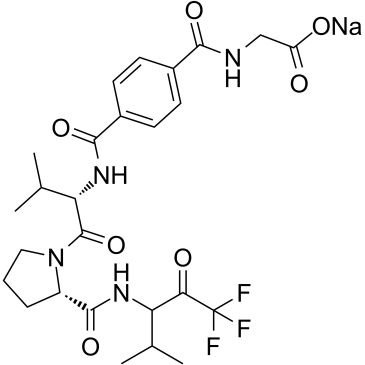| Description |
FK706 is a potent, slow-binding and competitive inhibitor of human neutrophil elastase with an IC50 of 83 nM and a Ki of 4.2 nM. FK706 also inhibits mouse neutrophil elastase and porcine pancreatic elastase with IC50s of 22 nM and 100 nM, respectively, and has no inhibitory activity against other serine proteinases such as human pancreatic trypsin, human pancreatic α-chymotrypsin and human leukocyte cathepsin G. FK706 has anti-inflammatory effect[1][2].
|
| Related Catalog |
|
| Target |
IC50: 83 nM (Human neutrophil elastase), 22 nM (Mouse neutrophil elastase) and 100 nM (Porcine pancreatic elastase)[1]; Ki: 4.2 nM (Human neutrophil elastase)[1]
|
| In Vitro |
FK706 effectively inhibits the hydrolysis of bovine neck ligament elastin (2 mg/mL final concentration) by human neutrophil elastase (4 μg/mL final concentration) with an IC50 value of 230 nM[1]. FK706 blocks the release of inflammatory chemokines, suppresses the expression of IL-8 and MCP-1 mRNA, and suppresses NF-κB activation. It seems possible that FK706 may directly blocks human lung fibroblasts activation of NF-κB, preventing expression of inflammatory chemokines during cigarette smoke–induced lung inflammation[2].
|
| In Vivo |
FK706 (10-100 mg/kg; subcutaneous injection; for 1-6 hours; male C57BL mice) treatment significantly suppresses human neutrophil elastase (20 μg/paw)-induced paw edema in mice in a dose-dependent manner (47% inhibition at a dose of 100 mg/kg)[1]. Animal Model: Male C57BL mice (6 weeks old) injected with human neutrophil elastase[1] Dosage: 10 mg/kg, 32 mg/kg, 100 mg/kg Administration: Subcutaneous injection; for 1 hour, 2 hours, 4 hours, 6 hours Result: Significantly suppressed human neutrophil elastase-induced paw edema in mice in a dose-dependent manner.
|
| References |
[1]. Shinguh Y, et al. Biochemical and pharmacological characterization of FK706, a novel elastase inhibitor. Eur J Pharmacol. 1997 Oct 15;337(1):63-71. [2]. Numanami H, et al. Serine protease inhibitors modulate smoke-induced chemokine release from human lung fibroblasts. Am J Respir Cell Mol Biol. 2003 Nov;29(5):613-9.
|
